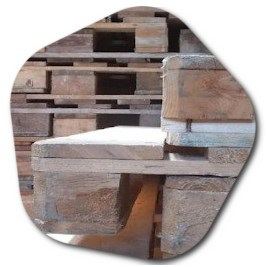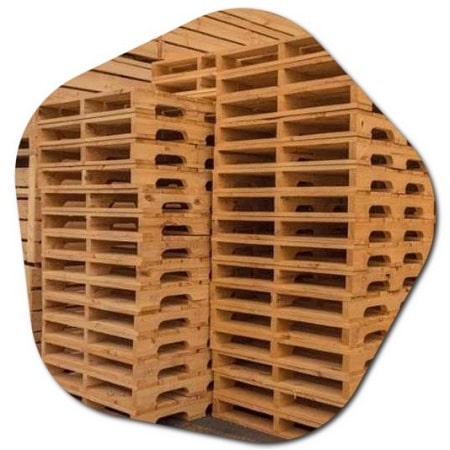Wooden pallets can be made from a variety of wood types, with the choice of wood depending on factors such as cost, durability, and intended use. Oak pallets are pallets constructed primarily from oak wood, a dense and durable hardwood known for its strength and longevity. Oak pallets are often chosen for heavy-duty applications and when long-term durability is essential.
Some common types of wood used for making wooden pallets include:
- Softwood: Softwood pallets are often made from wood sourced from coniferous trees such as pine, spruce, fir, and cedar. These woods are readily available and cost-effective, making them popular choices for pallet construction. Softwood pallets are lighter but may be less durable than hardwood pallets.
- Hardwood: Hardwood pallets are typically constructed from wood sourced from deciduous trees like oak, maple, cherry, and walnut. Hardwood pallets are known for their strength and durability, making them suitable for heavy-duty and long-term use. However, they can be more expensive than softwood pallets.
- Engineered Wood Products: Some pallets are made from engineered wood products like plywood and particleboard. These materials are created by bonding wood fibers or layers together, offering a combination of strength and cost-effectiveness.
- Reclaimed or Recycled Wood: Many pallets are made from reclaimed or recycled wood, which can come from a variety of sources. Reclaimed wood pallets are environmentally friendly and can have a unique, weathered appearance. They are often used for projects with an emphasis on sustainability and aesthetics.

The choice of wood for pallets depends on the specific requirements of the pallet, including load capacity, transportation, and storage conditions. It’s essential to consider the intended use of the pallet and any regulations or industry standards that apply to the handling and transportation of goods.
What kind of wood are pallets made from?
Pallets are typically made from a variety of wood types, and the specific kind of wood used can vary depending on factors such as cost, availability, intended use, and regional preferences. Some common types of wood used for making pallets include:
Softwood: Softwood pallets are often made from wood sourced from coniferous trees such as pine, spruce, fir, and cedar. These woods are readily available and cost-effective, making them popular choices for pallet construction. Softwood pallets are lightweight but may be less durable than hardwood pallets.
Hardwood: Hardwood pallets are typically constructed from wood sourced from deciduous trees like oak, maple, cherry, and walnut. Hardwood pallets are known for their strength and durability, making them suitable for heavy-duty and long-term use. However, they can be more expensive than softwood pallets.
Reclaimed or Recycled Wood: Many pallets are made from reclaimed or recycled wood, which can come from a variety of sources. Reclaimed wood pallets are environmentally friendly and can have a unique, weathered appearance. They are often used for projects with an emphasis on sustainability and aesthetics.
Engineered Wood Products: Some pallets are made from engineered wood products like plywood, oriented strand board (OSB), or particleboard. These materials are created by bonding wood fibers or layers together, offering a combination of strength and cost-effectiveness.
The choice of wood for pallets depends on the specific requirements of the pallet, including load capacity, transportation, and storage conditions. Pallet manufacturers may also consider factors such as durability, weight, and resistance to environmental factors when selecting the type of wood to use for pallet construction. It’s important to note that the use of heat-treated or chemically treated wood is common to meet international shipping and safety standards and to prevent the spread of pests or diseases through pallets.
How can you tell if a pallet is pine or oak?
Determining whether a pallet is made from pine or oak can be challenging, as the wood used for pallets is often not clearly labeled, and the appearance of the wood may vary depending on factors such as the age of the pallet, exposure to the elements, and any treatments applied to the wood. However, there are some general characteristics you can look for to make an educated guess:
- Color: Oak wood typically has a lighter, yellow to light brown color when freshly cut, while pine wood tends to be lighter in color, ranging from a pale yellow to a light, whitish tone. Over time, both types of wood can darken and develop a more weathered appearance.
- Grain Pattern: Oak has a distinct and prominent grain pattern with visible rays and open pores, giving it a textured and characteristic appearance. Pine, on the other hand, generally has a more uniform and fine grain pattern, which may be less pronounced.
- Density and Weight: Oak is a denser and heavier hardwood compared to pine, which is a lighter softwood. If you have multiple pallets and one feels significantly heavier, it may be an oak pallet.
- Hardness: If you can safely perform a simple scratch or dent test, oak is significantly harder and more resistant to scratches than pine. Pine wood is softer and may show marks more easily.
- Knots: Pine wood often features prominent knots, which can be more visible and larger than those found in oak.
- End Grain: Examine the end grain of the boards on the pallet. Oak typically has a more pronounced and distinctive end grain pattern compared to pine, with its characteristic rays and pores.

It’s important to note that some pallets may be made from a mix of wood types, making it more challenging to identify the primary wood species. Additionally, pallets can vary in appearance due to factors such as wear and exposure to the elements. When in doubt, consulting with a wood expert or performing a professional wood identification may be necessary for a more accurate determination of the wood species.
What area of the tree is used to make the pallet?
Pallets are typically constructed using various parts of a tree, depending on the design and the specific requirements of the pallet. The primary components of a pallet include:
- Deckboards: The deckboards are the top and bottom horizontal boards of the pallet, and they are the parts of the pallet that come into direct contact with the items being transported. Deckboards can be made from both hardwood and softwood and are typically chosen for their durability and smooth surface.
- Stringers or Stringer Boards: Stringers are the vertical or diagonal boards that run between the top and bottom deckboards, providing support and stability to the pallet. Stringers are usually made from hardwood for added strength.
- Blocks: In some pallet designs, blocks or cleats may be used instead of stringers to support the top and bottom deckboards. These blocks are typically placed at the corners of the pallet and provide additional stability and load-bearing capacity.
- Pallet Boards or Slats: In certain pallet designs, additional boards or slats may be used to reinforce the structure or provide extra support for the load. These boards can be made from various parts of the tree, including both hardwood and softwood.
In summary, different parts of the tree, both hardwood and softwood, can be used to make various components of a pallet, depending on the pallet’s intended use and design. The choice of wood for each component is typically based on factors like strength, durability, and cost-effectiveness.
What is a pallet made out of?
Pallets are typically made out of wood, but they can also be constructed from other materials, including plastic, metal, or composite materials. The choice of material depends on the specific requirements of the pallet, its intended use, and factors such as cost, durability, and environmental considerations. Here are the most common materials used for making pallets:
- Wood: Traditional wooden pallets are widely used and can be made from various types of wood, including softwood (e.g., pine, spruce) and hardwood (e.g., oak, maple). Wood pallets are known for their affordability, recyclability, and ease of repair. They are suitable for various applications but may not be as durable as some alternative materials.
- Plastic: Plastic pallets are durable, resistant to moisture and chemicals, and have a longer lifespan than wooden pallets. They are often used in industries where hygiene and cleanliness are critical, such as food and pharmaceuticals. Plastic pallets are also lightweight and can be a good choice for international shipping because they are not subject to international wood treatment regulations.
- Metal: Metal pallets are strong and durable, making them suitable for heavy-duty applications and long-term use. They are resistant to fire, pests, and environmental factors. However, they can be relatively expensive and heavy, which can impact transportation costs.
- Composite Materials: Composite pallets are constructed using a combination of materials, such as wood and plastic, to take advantage of the strengths of both materials. These pallets offer a balance between durability, cost-effectiveness, and sustainability.
- Paperboard or Cardboard: Paperboard or cardboard pallets are typically used for lightweight or one-time shipping applications. They are inexpensive and recyclable but lack the durability of other materials.
The choice of material for a pallet depends on factors like load capacity, the need for sanitation, environmental concerns, and budget constraints. Wooden pallets remain the most common type due to their cost-effectiveness and versatility, but alternative materials are gaining popularity in specific industries and applications.
Information about the oak pallet
Oak pallets are pallets constructed primarily from oak wood, a dense and durable hardwood known for its strength and longevity. Oak pallets are often chosen for heavy-duty applications and when long-term durability is essential. Here is some brief information about oak pallets:
- Durability: Oak is a hardwood with excellent durability, making it ideal for pallets that will carry heavy loads or endure rough handling. Oak pallets are known for their resistance to wear and tear.
- Strength: Oak wood is strong and can withstand significant weight and pressure, making it suitable for applications in industries like manufacturing, construction, and transportation.
- Weight: Oak pallets tend to be heavier than pallets made from softer woods, which can be advantageous for stability but may impact transportation costs.
- Cost: Oak pallets are often more expensive than those made from softwoods due to the quality and durability of the wood. However, their longer lifespan can justify the investment in some cases.
- Sustainability: Some oak pallets may be sourced from sustainably managed forests, and recycling or reusing oak pallets can contribute to sustainability efforts.
- Use Cases: Oak pallets are commonly used in industries where durability and strength are critical, such as for heavy machinery, large equipment, and products that need extra protection during transportation.
- Maintenance: Oak pallets are relatively low-maintenance but may require occasional repairs or replacement due to wear and tear.
It’s essential to consider the specific requirements of your application when choosing the type of pallet material, as oak pallets may be overkill for lighter loads or short-term use.
